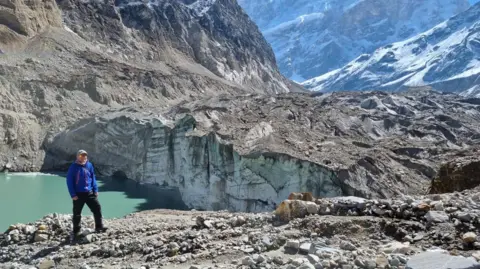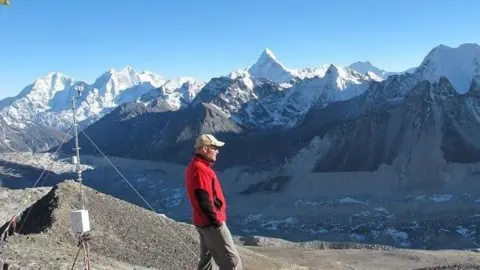Everest glacier temperature tested by academics
 University of Leeds
University of LeedsA team of academics is putting together a mission to discover whether snows around the world's highest mountain may be melting more quickly than previously thought.
The team, led by Leeds University professor Duncan Quincey and researchers from Aberystwyth University, aims to use new technology to chart the state of the Khumbu Glacier, above Mount Everest's base camp.
Leaving in spring 2025, they plan to use a new lightweight drill set up to breach the surface of the glacier and use boreholes to record temperatures.
They will also install automatic weather stations and hope their findings could help aid understanding of changes to glaciers worldwide.
 University of Leeds
University of LeedsDespite air temperatures being well below zero, it is believed that the snow in the Western Cwm region of Everest may be thawing.
If this was the case, it could suggest that the glaciers in the Himalayas were melting faster than expected.
A Leeds University spokesperson said glaciers in the highest mountains of the planet were an extremely important source of water with more than a billion people - including many in India, Pakistan and Bangladesh - depending on Himalayan runoff.
Changes in the rate of glacier thawing would threaten this water supply.
Melting could also cause more flooding from failures of natural ice dams, the university said.
Scientific observations are rarely made at high altitudes because of the logistical challenges in transporting equipment.
Prof Quincey, from the university's school of geography, said: "Our previous work has relied on helicopters to transport our equipment onto the glacier but given how thin the air is in the Western Cwm, we can't be sure the helicopters will be able to fly this time.
"We also won’t know how the equipment will fare in such a harsh climate as could also be said of the human body," he added.
The new project follows previous findings by the researchers which showed that the temperature of the ice in the lower parts of Khumbu Glacier, at the foot of Mount Everest, is warmer than would be expected given the local air temperature.
Understanding 'critical'
Prof Bryn Hubbard, of Aberystwyth University, said: "It may well be a bit of a surprise to many that snow is melting within the mountain’s Western Cwm, but it is increasingly likely, and it needs to be investigated and measured if we are going to be able to identify the effects of climate change on this water-stressed region and beyond.
"Understanding and recording what actually happens inside these glaciers is critical to developing computer models of their response to anticipated climate change," he said.
Prof Quincey added: "If we can successfully drill even a single borehole within the Western Cwm, that will be a major success."
The project is funded by the Natural Environment Research Council.
Listen to highlights from West Yorkshire on BBC Sounds, catch up with the latest episode of Look North or tell us a story you think we should be covering here.
